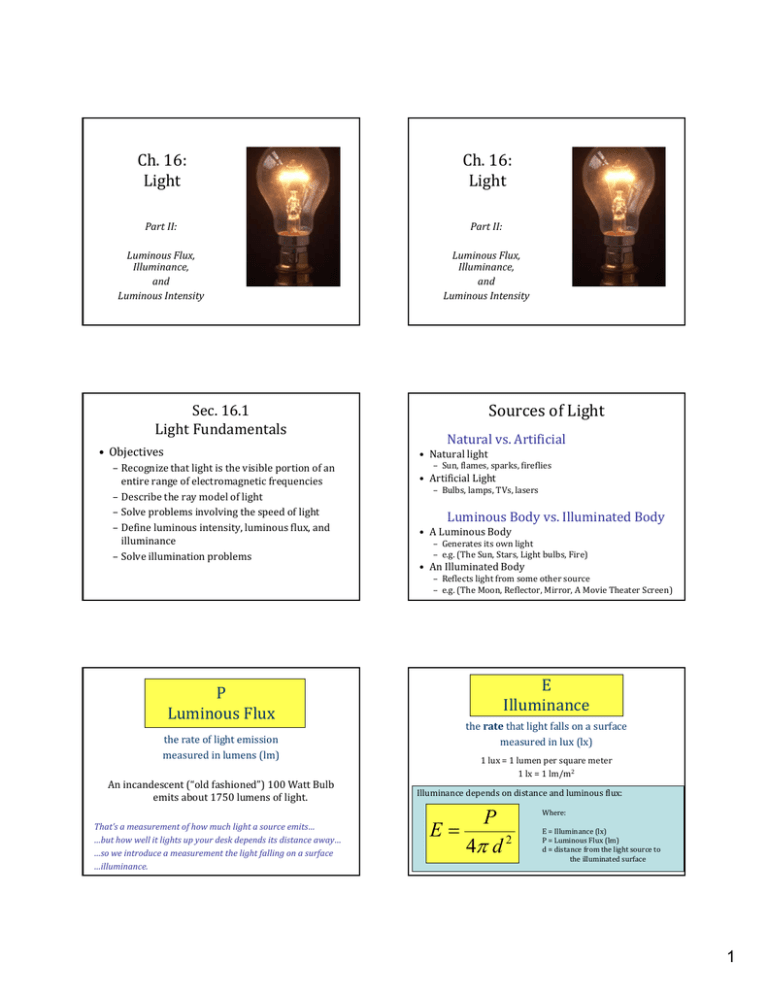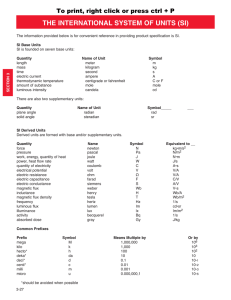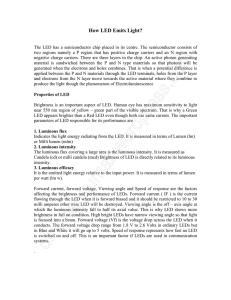Light
advertisement

Ch. 16: Light Ch. 16: Light Part II: Part II: Luminous Flux, Illuminance, and Luminous Intensity Luminous Flux, Illuminance, and Luminous Intensity Sec. 16.1 Light Fundamentals • Objectives Sources of Light Natural vs. Artificial • Natural light – Recognize that light is the visible portion of an entire range of electromagnetic frequencies – Describe the ray model of light – Solve problems involving the speed of light – Define luminous intensity, luminous flux, and illuminance – Solve illumination problems – Sun, flames, sparks, fireflies • Artificial Light – Bulbs, lamps, TVs, lasers Luminous Body vs. Illuminated Body • A Luminous Body – Generates its own light – e.g. (The Sun, Stars, Light bulbs, Fire) • An Illuminated Body – Reflects light from some other source – e.g. (The Moon, Reflector, Mirror, A Movie Theater Screen) P Luminous Flux the rate of light emission measured in lumens (lm) An incandescent (“old fashioned”) 100 Watt Bulb emits about 1750 lumens of light. That’s a measurement of how much light a source emits… …but how well it lights up your desk depends its distance away… …so we introduce a measurement the light falling on a surface …illuminance. E Illuminance the rate that light falls on a surface measured in lux (lx) 1 lux = 1 lumen per square meter 1 lx = 1 lm/m2 Illuminance depends on distance and luminous flux: P E 4 d 2 Where: E = Illuminance (lx) P = Luminous Flux (lm) d = distance from the light source to the illuminated surface 1 I Luminous Intensity the amount of light that falls on a defined surface measured in candela (cd) 1 candela = 1 “candle power” the amount of light that a 1 lumen source would shed on 1 m2 of a 1 m radius sphere if the source were in its center. Luminous Intensity does not involve distance from a source: Summary Quantity Symbol Units Luminous Flux P lumens (lm) Illuminance E lux (lx) Luminous Intensity I candela (cd) Formula P 4 I or P 4 d E 2 E I = Luminous Intensity (cd) P = Luminous Flux (lm) the rate of light emission (1 lm = 4 cd) P 4 d 2 the rate light falls on a flat surface (1 lx = 1 lm/m2) P 4 the amount of light that falls on a part of a sphere (S.I. base unit) Where: P I 4 Definition I asdf Sec. 16.2 Light and Matter • Objectives Light and Matter • Transparent – Explain the formation of color by light and by pigments or dyes – Explain the cause and give examples of interference in thin films – Describe methods of producing polarized light – glass • Translucent – Lamp shades – Frosted light bulbs • Opaque – bricks Color • Spectrum • Primary Colors – Red, green, blue • Secondary Colors – – – – Yellow, cyan, magenta R+B = M B+G = C G+R = Y • White Colors Con’t • Complementary colors – The primary color that will turn a secondary color of light white is its complement. Example: – Yellow made from red and green light – Yellow + blue = white – Thus, yellow is the complementary color to blue. • Same intensities of red, green, and blue 2 Color by subtraction • Dye – Molecule that absorbs certain wavelengths of light and transmits others – Pigments are like dyes, only they are made from large particles rather than molecules – (Dyes form solutions, pigments form suspensions) Formation of Colors in Thin Films • Soap bubble, oily films • Results of constructive and destructive interference of light – Thin-film interference • Primary Pigment – Absorbs one primary color from white light – Reflects Yellow, cyan, or magenta • Secondary Pigment – Absorbs two primary colors – Reflects Red, green, or blue Polarization • The intensity of the light is reduced by half • Light travels in two planes – Polarizing material cancels out one of the planes Review Questions • What colors does white light consist of? • Is black a color? • Why are the insides of binoculars and cameras painted black? • You put a piece of red cellophane over one flashlight and a piece of green cellophane over another. You shine the light beams on a white wall. What color will you see where the two flashlight beams overlap? 3





